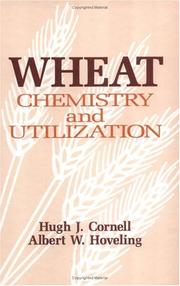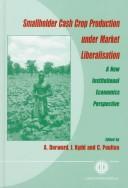| Listing 1 - 5 of 5 |
Sort by
|

ISBN: 1566763487 9781566763486 Year: 1998 Publisher: Lancaster, PA : Technomic Publishing Co.,
Abstract | Keywords | Export | Availability | Bookmark
 Loading...
Loading...Choose an application
- Reference Manager
- EndNote
- RefWorks (Direct export to RefWorks)
Periodical
Year: 1998 Publisher: Topeka, KS : Topeka, Kansas : Topeka, Kansas : Topeka, Kansas : Topeka KS : Topeka, KS : Kansas Dept. of Agriculture, Kansas Dept. of Agriculture ; U.S. Dept. of Agriculture Kansas Dept. of Agriculture, Division of Statistics ; National Agricultural Statistics Service Kansas Dept. of Agriculture, Division of Statistics U.S. Dept. of Agriculture, National Agricultural Statistics Service, Kansas Field Office U.S. Dept. of Agriculture, National Agricultural Statistics Service
Abstract | Keywords | Export | Availability | Bookmark
Book
ISBN: 0852636237 Year: 1998 Publisher: Princes Risborough : Shire,
Abstract | Keywords | Export | Availability | Bookmark
 Loading...
Loading...Choose an application
- Reference Manager
- EndNote
- RefWorks (Direct export to RefWorks)
Flour mills --- Wheat --- History. --- Milling --- History.
Book
Year: 1998 Publisher: Washington, D.C. : The World Bank,
Abstract | Keywords | Export | Availability | Bookmark
 Loading...
Loading...Choose an application
- Reference Manager
- EndNote
- RefWorks (Direct export to RefWorks)
The growth of agriculture output over the past 200 years has been phenomenal. When Malthus wrote in 1798, he perceived limits on agricultural production as serious and imminent. Since then world population has increased by six-fold and global agricultural production has more than kept pace. Falling real grain prices for most of the 20th Century are cited as evidence. The sources of the increase in food production, however, have been quite different and have come in distinct waves. For most of the 19th century, increased output came from expanded land area in production. Science-based agriculture is really a post-Mendel phenomenon. In the 20th century, new technology came in different forms. First, mechanical technology, particularly the tractor, made possible cultivating more acres and freed enormous areas used for producing fuel for draft animals, for food production. Improvements in breeding and agronomy in the middle part of the century opened the possibility of substantially increasing yields per unit of land through the use of chemical fertilizers and pesticides. As we look to the 21st century, this conference is asking a critical question about the role of knowledge, science and technology in meeting future global food needs.
Agricultural Extension Services --- Agricultural Knowledge & Information Systems --- Agricultural Research --- Agriculture --- Biotechnology --- Cancer --- Decentralization --- Deforestation --- Developed Countries --- Environment --- Environmental Economics & Policies --- Farming --- Food & Beverage Industry --- Food Production --- Food Security --- Global Warming --- Grains --- Green Revolution --- Industry --- Integrated Pest Management --- Intellectual Property Rights --- International Food Policy Research Institute --- Irrigation --- Maize --- Marketing --- Meat --- Natural Resources --- Pesticides --- Population Growth --- Private Sector --- Research Agenda --- Rice --- Risk Management --- Rural Development --- Trade Liberalization --- Trees --- Urbanization --- Water Pollution --- Wheat

ISBN: 0851992773 Year: 1998 Publisher: Wallingford CAB international
Abstract | Keywords | Export | Availability | Bookmark
 Loading...
Loading...Choose an application
- Reference Manager
- EndNote
- RefWorks (Direct export to RefWorks)
633 --- Cash crops --- -Cashew nut industry --- -Cotton trade --- -Wheat trade --- -338.439 --- 338.24 <1-772> --- 658.8 --- 633.51 --- 634.573 --- 633.11 --- <549> --- <678> --- <667> --- Wheat industry --- Grain trade --- Textile industry --- Cashew industry --- Cashew trade --- Nut industry --- Crops --- Field crops and their production --- Case studies --- Economie van de voedselproductie. Economie van de voedingsindustrie. --- Instrumenten van de economische politiek. Economische orde. Economisch politieke maatregelen. Stabilisering. Stimuleringsmaatregelen. Regulering. Financiele steunmaatregelen--Onontwikkelde, onderontwikkelde gebieden --- Marketing. Sales. Selling. Distribution --- Cotton and similar fibres --- Cashew nut. Anacardium occidentale --- Wheats. Triticum --- Pakistan --- Tanzania --- Ghana --- Cashew nut industry --- Cotton trade --- Wheat trade --- Social Sciences and Humanities. Marketing --- Case studies. --- Agricultural Marketing --- Agricultural Marketing. --- <667> Ghana --- <678> Tanzania --- <549> Pakistan --- 633.11 Wheats. Triticum --- 634.573 Cashew nut. Anacardium occidentale --- 633.51 Cotton and similar fibres --- 658.8 Marketing. Sales. Selling. Distribution --- 338.24 <1-772> Instrumenten van de economische politiek. Economische orde. Economisch politieke maatregelen. Stabilisering. Stimuleringsmaatregelen. Regulering. Financiele steunmaatregelen--Onontwikkelde, onderontwikkelde gebieden --- 338.439 Economie van de voedselproductie. Economie van de voedingsindustrie. --- 633 Field crops and their production --- 338.439 --- Economie van de voedselproductie. Economie van de voedingsindustrie
| Listing 1 - 5 of 5 |
Sort by
|

 Search
Search Feedback
Feedback About UniCat
About UniCat  Help
Help News
News